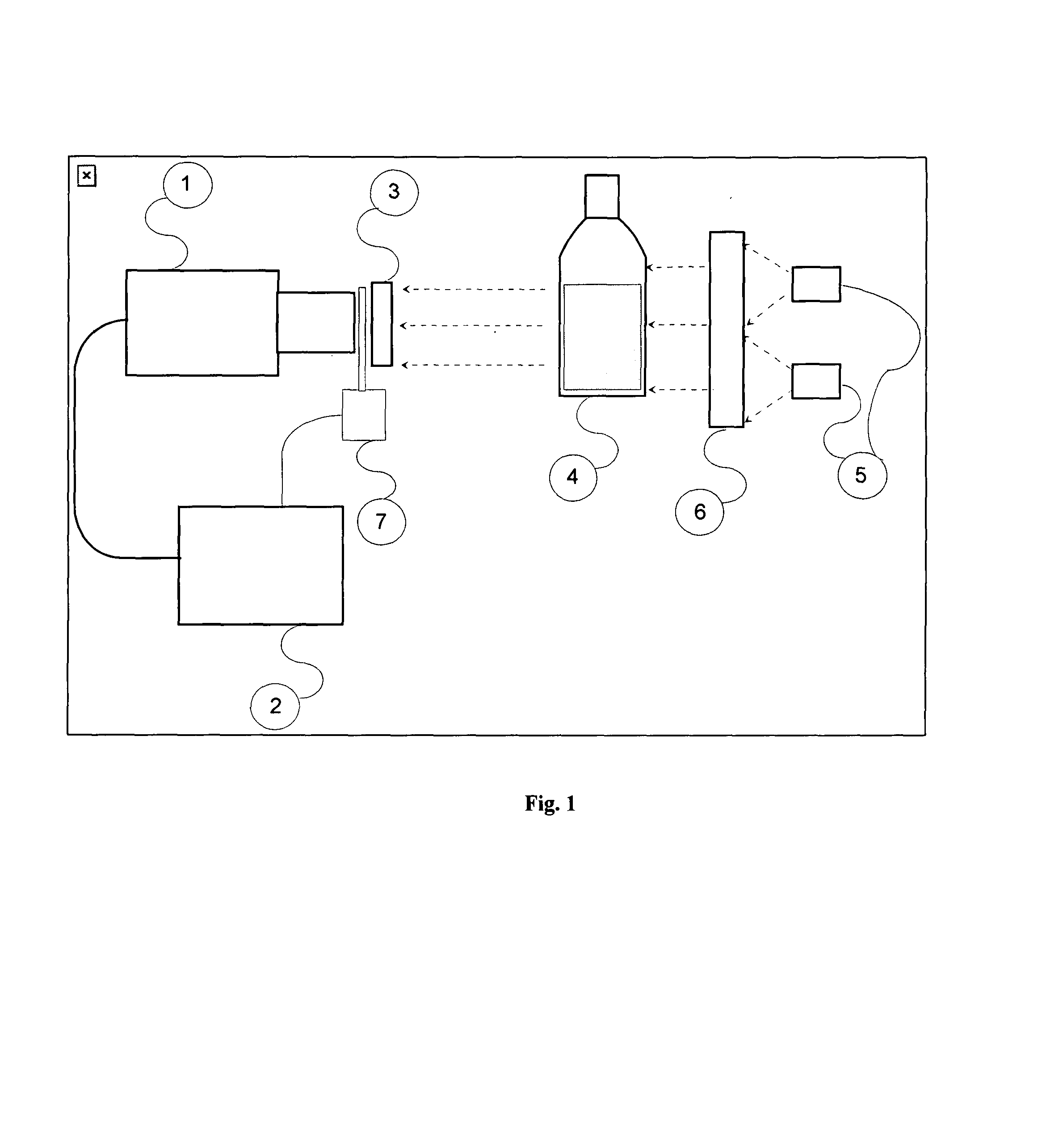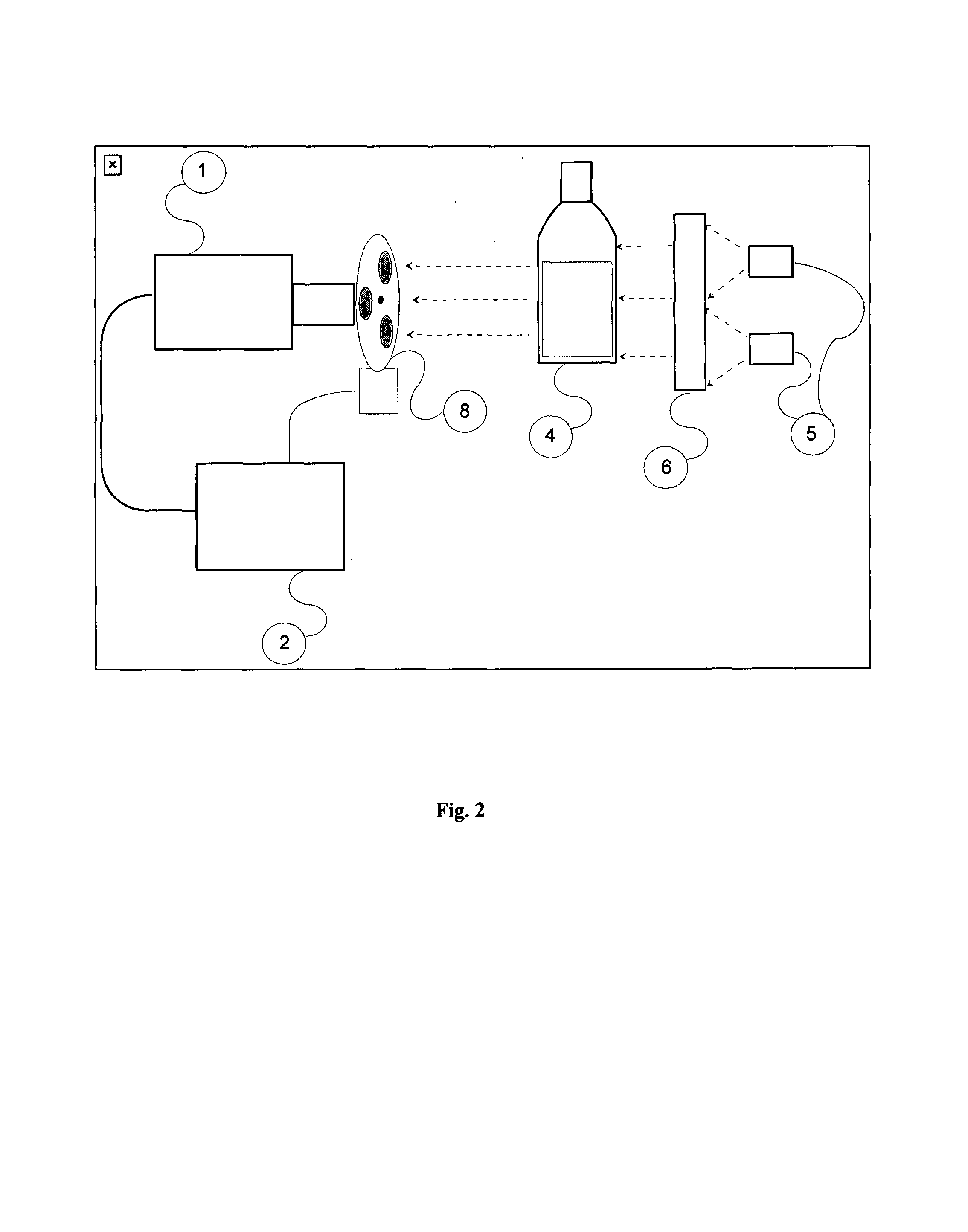Optical system and method for inspection and characterization of liquids in vessels
- Summary
- Abstract
- Description
- Claims
- Application Information
AI Technical Summary
Benefits of technology
Problems solved by technology
Method used
Image
Examples
example 1
Test Results Demonstrating Single Wavelength Near-Infrared (NIR) Image Screening of Liquids in Bottles for Hazardous Liquids Vs. Soft Drinks in Plastic Bottles
[0173]A set of test images of plastic and glass bottles containing water and organic based liquids were recorded both in the visible wavelength range and in the NIR at 980 nm with a consumer video camera operating in the digital camera mode. The camera (Sony® HCR-360 camcorder) has a Si-CCD array detector and has a high gain NIR “nightshot” mode where the camera can see near-infrared light in the 700 to 1000 nm range. The NIR images were measured through a 980 nm center wavelength interference filter with a 10 nm bandpass which was mounted just in front of the camera lens. The NIR images used in this example did not receive any correction with dark or with illumination source background images.
[0174]The test images shown in FIGS. 5-7 demonstrate that flammable organic liquids like gasoline, kerosene and nitromethane (a liquid ...
example 2
[0176]Additional measurements were conducted with a NIR hyperspectral imaging system (Spectral Dimensions™ Matrix-NIR), and also with a single point near-infrared Fourier-transform spectrometer (for nitromethane and water only) to measure the absorbance at 980 nm for several water-based soft drinks (including spring water) and also several flammable liquids, including nitromethane.
[0177]The hyperspectral imaging system employed a InGaAs diode array camera together with an electronically tunable liquid crystal narrow bandpass filter with a 6 nm bandpass. The tunable filter was set at 980 nm for these absorbance measurements. Using the hyperspectral imaging system, the absorbance and standard deviation were calculated for the 10 image points from each bottle tested. The absorbance results are given in Table 1 below, and show that the absorbance through the water based liquids was consistently higher than that through the organic liquids by about a factor of 6. The absorbance measureme...
example 3
Two Wavelength Differential Wavelength Transmission Imaging of Softdrink Bottles Showing Reduced Interference from Bottle Labels and Cardboard Container Walls
[0179]Additional NIR transmission imaging measurements of the same plastic bottles of cranberry juice and kerosene shown in FIG. 4 were measured with the NIR hyperspectral imaging system described above at both 980 and 1050 nm, using the tunable 6 nm bandwidth liquid crystal narrow bandpass filter to select the wavelength bands. The images at 980 and 1050 nm were converted to absorbance and then subtracted (980 nm ABS image minus 1050 nm ABS image) using image processing software to produce a differential wavelength image.
[0180]In FIG. 7 and FIG. 8, the differences between a single wavelength image (in ABS units) at 980 nm can be compared with the differential wavelength image measured between 980 and 1050 nm for the bottles of cranberry juice and kerosene. The images in FIG. 7 and FIG. 8 demonstrate that the differential wavel...
PUM
 Login to View More
Login to View More Abstract
Description
Claims
Application Information
 Login to View More
Login to View More - R&D
- Intellectual Property
- Life Sciences
- Materials
- Tech Scout
- Unparalleled Data Quality
- Higher Quality Content
- 60% Fewer Hallucinations
Browse by: Latest US Patents, China's latest patents, Technical Efficacy Thesaurus, Application Domain, Technology Topic, Popular Technical Reports.
© 2025 PatSnap. All rights reserved.Legal|Privacy policy|Modern Slavery Act Transparency Statement|Sitemap|About US| Contact US: help@patsnap.com



